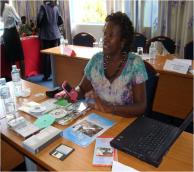Rural Women Farmers in Uganda Increasing their use of ICTs

Photo credit: Ntulume Village Women's Association
Rural women farmers are increasing their use of ICTs, a recent project evaluation for Women of Uganda Network (WOUGNET) revealed. The project, “Enhancing Access to Agricultural Information” began in 2005 with the goal of developing and improving information and communication systems to provide access to agricultural information for rural women farmers via a variety of ICTs including mobile phones, radio cassettes, and community radio. A five year evaluation of the project indicates that not only had ICT usage increased since inception, but the range of reasons why the rural women farmers used ICTs had broadened to include access to market information, reach out to agricultural extension workers, and participation in community radio shows as panelists and by calling-in.
Approximately 85% of farmers in Africa are women, and technology is consistently becoming a more important tool for communication in rural areas. Dorothy Okello, Director of WOUGHNET, wrote on her blog on e-Agriculture, that the organization has come up with the following key lessons:
- While e-Agriculture projects are possible with rural communities, no one technology can be used in isolation. Innovative use of available and affordable technologies has to be made.
- At the infrastructure level, pro-poor gender-sensitive ICT policies have to be in place to support ready access to affordable high-speed ICT infrastructure.
- Partnerships and collaborations are of paramount importance. For example, WOUGNET has partnered with national and local agricultural research institutions, universities and agricultural-focused organizations for their projects.
- ICT projects at community level require time. Since ICT projects do not always provide tangible inputs or outputs, people take long to appreciate them. The process of transfer from information to a final product is a process and the community needs time to understand, so such projects cannot be hurried or rushed.
- There is a clear relationship between the level of literacy and response to ICT-based innovations if community livelihoods are to be improved. In general, applications that are voice-based or image-based will fare better but may be more costly or more demanding of high-speed ICT infrastructure.
- ICT projects require social and technological skills as well as commitment of the various stakeholders.
- ICT projects can create an inclusive public sphere, for example, the aged, disabled can participate in such projects as they allow for participation in addition to anonymity and solidarity.





































